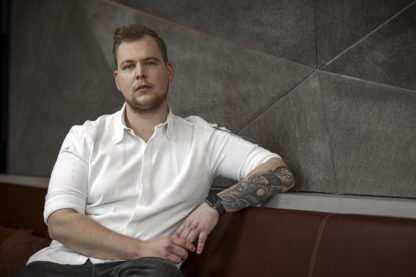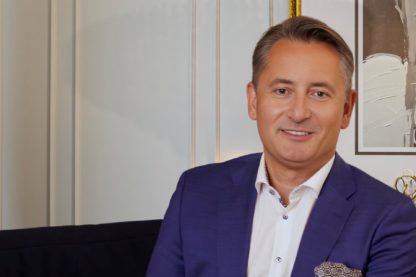Gheya Boulware, founder of Lord & Partners, brings experience across design, production, sales, and marketing. In this interview with Alexander Chetchikov, president of World Luxury Chamber of Commerce, she explains how luxury brands can assess their current position, address gaps in their operations, and make strategic decisions that support both creative vision and business growth.
Alexander Chetchikov: Gheya, with your experience across design, production, sales, and marketing, how do you approach assessing a luxury brand’s current equity and identifying the areas that need the most attention?
Gheya Boulware: My multi-faceted background is honestly my greatest superpower. Working across design, production, sales, and marketing gave me a full 360-degree view of how a luxury brand grows from concept to consumer. Early in my career, especially working with independent designers, I realized I wanted to understand the entire machine, not just one part of it. That balance between art and commerce is what allows me today to help luxury fashion and beauty brands understand their true equity and where they stand in the market.
When I assess a brand, I never look at marketing in isolation. Once I moved into marketing, I started to see how many business models were fragmented. The creative side would be running one way, the product team another, and the commercial side would be trying to catch up. Many founders assume brand equity comes only from storytelling or communications. It plays a role, but equity is built when product, brand, and business move in sync.
So my approach is holistic. I audit the product pipeline, pricing logic, innovation gaps, brand health, customer experience, and the commercial engine. I look for where the disconnects are, because when one area is weak, it drags the others down. There is rarely a single area that needs attention. The priority is creating an interconnected system where product strategy, brand positioning, and revenue strategy reinforce each other.
That’s when a brand gains real equity. That is the foundation luxury businesses need if they want longevity, not just a moment of hype.
AC: What inspired you to launch Lord & Partners, and how do you differentiate your consultancy from others in the luxury fashion and beauty space?
GB: I launched Lord & Partners because the next generation of luxury fashion and prestige beauty brands is facing a new kind of complexity. The industry is more commercial, more competitive, and more saturated than ever. Brands are expected to grow fast, innovate constantly, and still maintain a clear point of view. Most designers or founders don’t need another agency delivering fragmented PR or marketing work. They need a long-term partner who thinks about the entire brand and business.
Lord & Partners was built to fill that gap. We focus on holistic brand management, not isolated services. That means we support everything tied to growth: product strategy, innovation opportunities, whitespace evaluation, commercial planning, brand health, revenue optimization, and long-term brand equity. We streamline these pieces so the brand operates like a true luxury business, not a collection of disconnected activities.
Our difference is simple. We do not function as a traditional PR agency. We operate as a strategic partner with our clients and guide every decision that impacts brand valuation, market relevance, and long-term success.
AC: In your work with both global beauty groups and independent innovators, what common challenges do luxury brands face when maintaining their identity while pursuing growth?
GB: There are a lot of challenges at play in luxury, from broad economic pressures like inflation to shifts in consumer behavior. Those matter, but what I’ve consistently seen have the greatest impact are the internal conflicts happening long before external forces even hit. Many luxury fashion and beauty founders or executives assume the external market has the most power to disrupt a brand, yet those disruptions only become damaging when the brand isn’t structurally prepared to engage them.
The foundational pieces inside the business—talent, operations, creative clarity, commercial logic—set the tone for whether a brand can grow without losing itself. For independent designers, I noticed the issues usually stem from not having a fully scaled team. You see talent gaps, burnout, and creative direction that is strong artistically but not always translated into commercial strategy. With large beauty groups and independently owned beauty brands, the problems look different but come from the same root. You often see fragmented teams, creative and production divisions working in silos, and decision-making bottlenecks that slow the business down.
For new and emerging brands, the biggest struggle is that brand activities aren’t streamlined and teams often work in silos (if there even is a team). Limited budgets create talent gaps, which only magnify the pressure. Once growth hits, every weakness becomes visible. Scaling gets harder, decision-making slows, and creative and commercial priorities stop reinforcing each other. These brands need tighter operations and internal structures that can actually support momentum. This is where strategic brand equity partners like us step in. Lord & Partners becomes the brand equity and management partner that helps emerging luxury fashion and beauty brands close these gaps and move forward with cohesion.
AC: How do you guide emerging luxury fashion designers and beauty founders to make strategic decisions that build long-term brand value while still protecting their creativity and point of view?
GB: Most emerging founders start independently, even those who have been operating for years. They are talented and ambitious, but they are competing in a category where legacy houses already have capital, teams, and institutional knowledge that protect their dominance. New luxury brands need a lot of support in those early stages. They are still building brand equity in a space where the benchmarks are incredibly high.
Creatively, these founders have real stories and real authenticity, which matters deeply to today’s customers. The challenge is that luxury operates by a different playbook. Craftsmanship, consistency, and commercial structure have to be just as strong as the creative vision. Many designers know exactly what they want the product and collection narrative to be, but they also need a strategy that makes the business viable long term.
Our role is to stand beside these founders and reinforce both sides. We protect the story and the creative intent, while making sure there is a commercial path that supports growth. More specifically, we advise emerging luxury fashion and beauty brands across the full 360 degrees: brand management, brand equity, marketing and communications, go-to-market, CRM and loyalty, product and assortment strategy, operations, and revenue planning. We help them make decisions that align creativity with business logic so they can scale without losing the depth and meaning that make them luxury in the first place.
AC: Looking ahead, what trends or shifts do you see having the biggest impact on the luxury fashion and beauty industry over the next five to ten years?
GB: Fashion and beauty are different industries, but they move in parallel. Both are creative, highly commercial, and built on emotional impact. The shifts ahead will come from how consumers value creativity, experiences, and long-term brand trust.
For luxury fashion, we will see a continued slowdown in seasonal cycles. Creative director burnout and constant turnover at legacy houses are already signaling the need for more sustainable approaches. Emerging fashion brands will benefit from this shift because they can grow at their own pace without chasing trend cycles. As consumers pull back from overconsumption, we will see stronger interest in low-waste models, craftsmanship, and sustainability built into the product from day one. Once the global luxury slowdown stabilizes, aspirational customers will return with a different mindset: fewer pieces, better quality, deeper meaning.
For beauty, especially luxury and prestige, science will continue to be the backbone, but emotional appeal will be the differentiator. The next decade will bring bigger cross-industry collaborations, especially in travel and hospitality. Expect to see beauty brands creating spa-like environments, wellness concepts, and boutique-hotel experiences that let consumers feel the brand, not just buy it. The line between beauty, wellness, and luxury lifestyle will only get thinner.
Across both sectors, the reality is unchanged: this is still a business. Agency models will evolve. Brands cannot afford partners who only touch one piece of the puzzle. They will need strategic partners with a 360-degree understanding of product, brand, and business. Short-term buzz will matter less, and long-term brand equity will matter more.
Behind all of this, technology will reshape workflows. AI will advance creative production, product development, marketing, and operations. Luxury brands will adapt to a new consumer who values experiences over accumulation. Data will become central, and new metrics will emerge to measure true brand performance.
The next decade will reward brands that slow down, build smarter, and create deeper value at every single touchpoint.
Thank you, Gheya! Boulware’s approach shows that a luxury brand’s strength comes from integrating creative, operational, and commercial decisions. For emerging designers and established brands alike, thoughtful planning and cohesive execution are key to maintaining value and relevance in a competitive market.
Visit Lord and Partners to learn more.
Want to read more exclusives? Check out our news and insights: https://worldluxurychamber.com/insights-news/ & sign up for our newsletter here: https://worldluxurychamber.com/wlcc-community/





